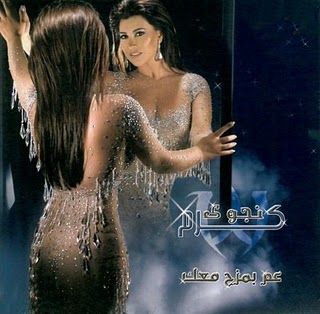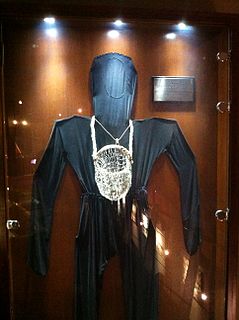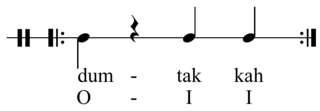 W
WArabic music or Arab music is the music of the Arab world with all its diverse music styles and genres. Arabic countries have many rich and varied styles of music and also many linguistic dialects, with each country and region having their own traditional music.
 W
W"Bechwech" "('slowly') is a song recorded by the Algerian singer Yasmine Nayar in 2016 and released as a single in 2016. The song was a considerable success in its native Algeria and also managed to reach on the number one spot on a number of countries like Egypt, Syria, Jordan and Lebanon.
 W
W"Eysh Eysh" "(What)" is a song recorded by the Algerian singer Yasmine Nayar in 2016 and released as a single in 2016. The song was a considerable success in its native Algeria and also managed to reach on the number one spot on a number of countries like Egypt, Syria, Jordan and Lebanon.
 W
WAm Bemzah Ma'ak is the seventeenth studio album from the Lebanese singer Najwa Karam. The album contains 8 tracks, and worked with the famous Lebanese composer Melhem Barakat on two songs. Najwa Karam already released a music video for the album's title, Aa Bemzah Ma'ak.
 W
WAndalusian classical music or Andalusi music is a genre of music originally developed in al-Andalus by the Native Muslim population of Andalusia and the Moors, it then spread and influenced many different styles across the Maghreb after the Expulsion of the Moriscos. It originated in the music of Al-Andalus between the 9th and 15th centuries. Some of its poems derive from famous authors such as Al-Shushtari, Ibn al-Khatib and Al-Mu'tamid ibn Abbad.
 W
WFrançoise Atlan is a French singer, born in a Sephardic Jewish family in Narbonne, France on 27 July 1964. Her father was a lawyer and native of Béjaïa, Algeria, and her mother was a pianist and a lyrical singer.
 W
WBasīṭ, or al-basīṭ (البسيط), is a metre used in classical Arabic poetry. The word literally means "extended" or "spread out" in Arabic. Along with the ṭawīl, kāmil, and wāfir, it is one of the four commonest metres used in pre-Islamic and classical Arabic poetry. The metrical form is often as follows :| x – u – | x u – | – – u – | u u – |
 W
WBaron Rodolphe d'Erlanger was a French painter and musicologist, specializing in North African and Arabic music.
 W
WFidjeri is the specific repertoire of vocal music sung by the pearl divers of Eastern Arabia's coastal Gulf states, especially Bahrain and Kuwait. A lead singer is backed up by a chorus of accompanying singers and clapping. The accompanying instruments to a fidjeri ensemble are a small double-sided hand-drum, known as the mirwās and the jāhlah, a clay pot played with both hands.
 W
WThe goblet drum (also chalice drum, tarabuka, tarabaki, darbuka, derbake, debuka, doumbek, dumbec, dumbeg, dumbelek, tabla, tablah, tableh, toumperleki, tumbak, or zerbaghali, is a single head membranophone with a goblet shaped body used mostly in Egypt and is considered the National symbol of Egyptian Shaabi Music, also in parts of the West Asia, North Africa, South Asia, and Eastern Europe. The African djembe-wassolou is also a goblet membranophone. This article focuses on the Eastern and North-African goblet drum.
 W
WA jins is a set of three, four, or five stepwise pitches used to build an Arabic maqam, or melodic mode. They correspond to the English terms trichord, tetrachord, and pentachord. A maqam is made up of two or more ajnas.
 W
WRobert Lachmann was a German ethnomusicologist, polyglot, orientalist and librarian. He was an expert in the musical traditions of the Middle East, a member of the Berlin School of Comparative Musicology and one of its founding fathers. After having been forced to leave Germany under the Nazis in 1935 because of his Jewish background, he emigrated to Palestine and established a rich archive of ethnomusicological recordings for the Hebrew University of Jerusalem.
 W
WYouTube is an American video-sharing website headquartered in San Bruno, California. "Lm3allem" by Moroccan singer Saad Lamjarred is the most viewed video in Arabic with 900 million views in February 2021. "Happy Happy" by Bahrani singer Hala Al Turk become the first Arabic music video to cross 100 million views. "Ya Lili" by Tunisian singer Balti with Hammouda is the second video to garner over 700 million views. This is a list of the most-viewed Arabic music videos on YouTube.
 W
WListen to the Banned is a compilation album that features the music of banned, censored and imprisoned artists from the Middle East, Africa and Asia. The album is the result of a two-year collaboration between the Norwegian artist Deeyah Khan and international organisation Freemuse. As well as receiving critical acclaim, Listen to the Banned album has peaked at number 6 on the World Music Charts Europe and spent months on these charts. The album was released worldwide in 2010
 W
WThe manjur is a musical instrument used in the Arab states of the Persian Gulf but with East African origins. It is made of goat hooves attached to a cloth. It is performed by tying the instrument around the waist. The performer shakes his or her hip to create a rattle sound when the hooves collide with each other.
 W
WIraqi Maqam is a genre of Arabic maqam music found in Iraq that is at least four-hundred years old. The ensemble of instruments used in this genre, called Al-Chalghi al-Baghdadi, includes a qari' (singer), santur, jawza, tabla or dunbug/dumbeg, and sometimes riqq and naqqarat. The focus is on the poem sung in classical Arabic or an Iraqi dialect. A complete maqam concert is known as fasl and is named after the first maqam: Bayat, Hijaz, Rast, Nawa, or Husayni.
 W
WY. Misdaq a.k.a. Yoshi is an Afghan-English multimedia artist, writer, creative consultant, and is founder of the art website Nefisa, which also doubles as an independent media label- Nefisa UK. Since 2004 he has released four albums, three documentaries and three novels, and most recently has released a poetry series as well as appearing on numerous works, either anonymously or under different pseudonyms as writer, filmmaker, and performer.
 W
WThe traditional music of Jordan has a long history. Rural zajal songs, with improvised poetry played with a mijwiz, tablah, arghul, oud, rabab and reed pipe ensemble accompanying is popular. The transition of old cultural music into hit pop songs known worldwide Recently, Jordan has seen the rise of several prominent DJs and popstars.
 W
WThe music of Palestine is one of many regional subgenres of Arabic music. While it shares much in common with Arabic music, both structurally and instrumentally, there are musical forms and subject matter that are distinctively Palestinian.
 W
WMuwashshah is the name for both an Arabic poetic form and a secular musical genre. The poetic form consists of a multi-lined strophic verse poem written in classical Arabic, usually consisting of five stanzas, alternating with a refrain with a running rhyme. It was customary to open with one or two lines which matched the second part of the poem in rhyme and meter; in North Africa poets ignore the strict rules of Arabic meter while the poets in the East follow them. The musical genre of the same name uses muwaššaḥ texts as lyrics, still in classical Arabic. This tradition can take two forms: the waṣla of Aleppo and the Andalusi nubah of the western part of the Arab world.
 W
WThe history of opera in the Arabic-speaking world is generally viewed to have started from the premiere of Verdi's Aida in Cairo at the Khedivial Opera House in 1871, though Verdi's opera was sung in Italian.
 W
WRaï, sometimes written rai, is a form of Algerian folk music that dates back to the 1920s. Singers of Raï are called cheb as opposed to sheikh, the name given to Chaabi singers. The tradition arose in the city of Oran, primarily among the poor. Traditionally sung by men, by the end of the 20th century, female singers had become common. The lyrics of Raï have concerned social issues such as disease and the policing of European colonies that affected native populations.
 W
WRhythms in Arabic music are rich and very diverse, as they cover a huge region and peoples from Northern Africa to Western Asia. Rhymes are mainly analysed by means of rhythmic units called awzan and iqa'at.
 W
WSafi al-Din al-Urmawi al-Baghdadi or Safi al-Din Abd al-Mu'min ibn Yusuf ibn al-Fakhir al-Urmawi al-Baghdadi was a renowned musician and writer on the theory of music, possibly of Persian origin.
 W
WGuillaume André Villoteau was a French musicologist.